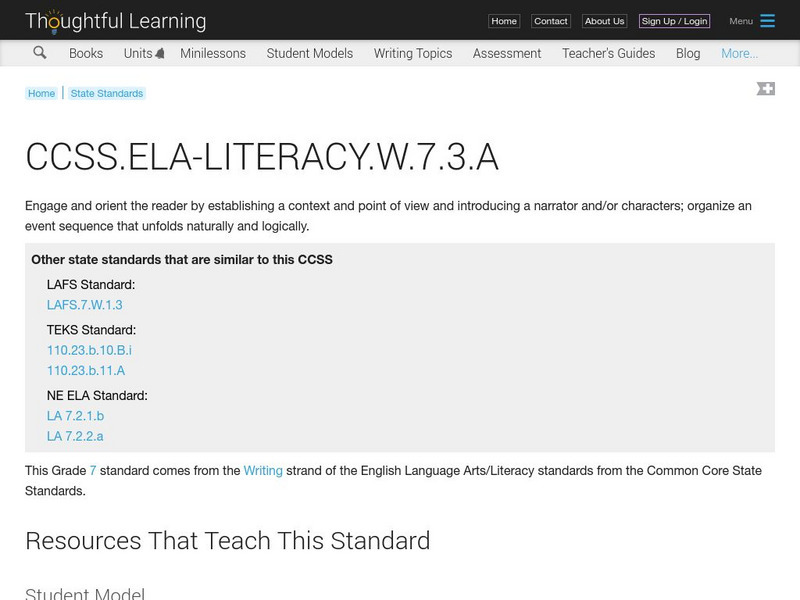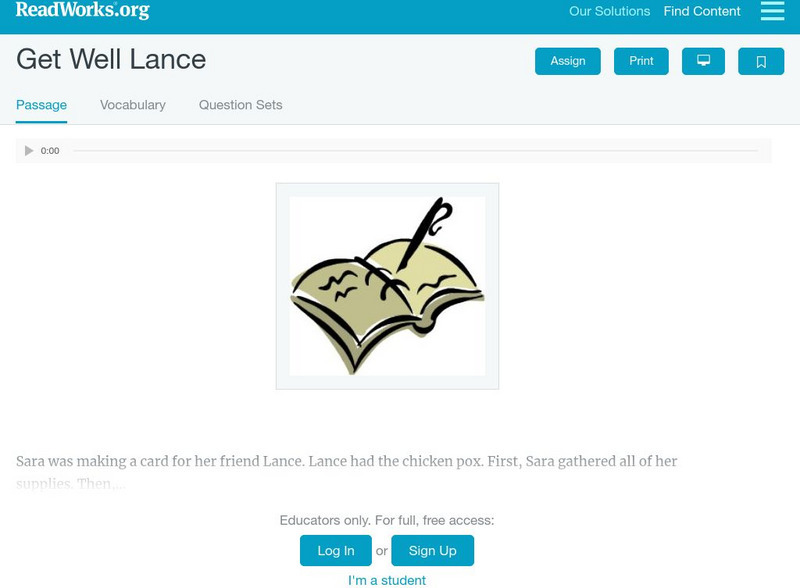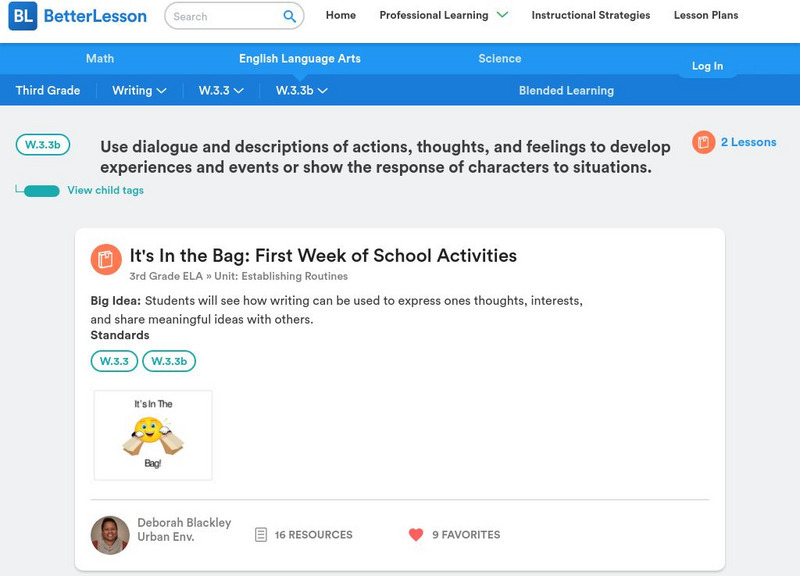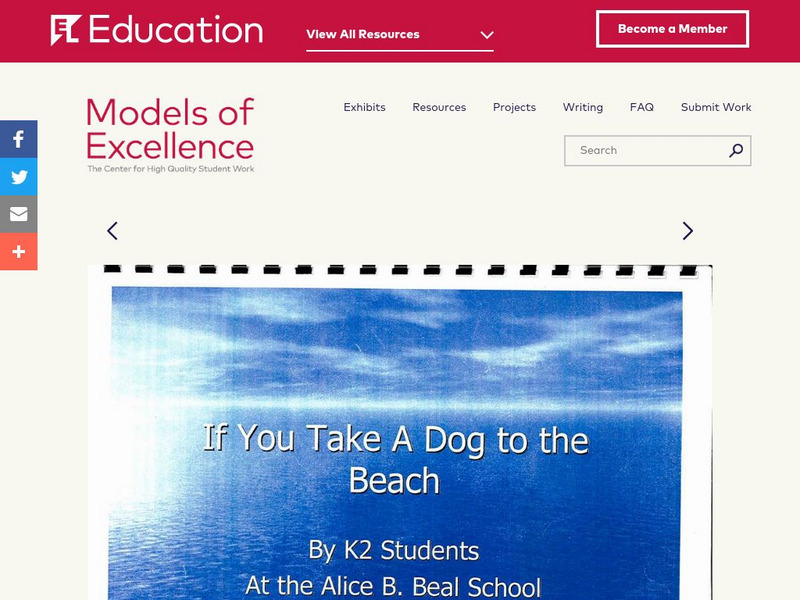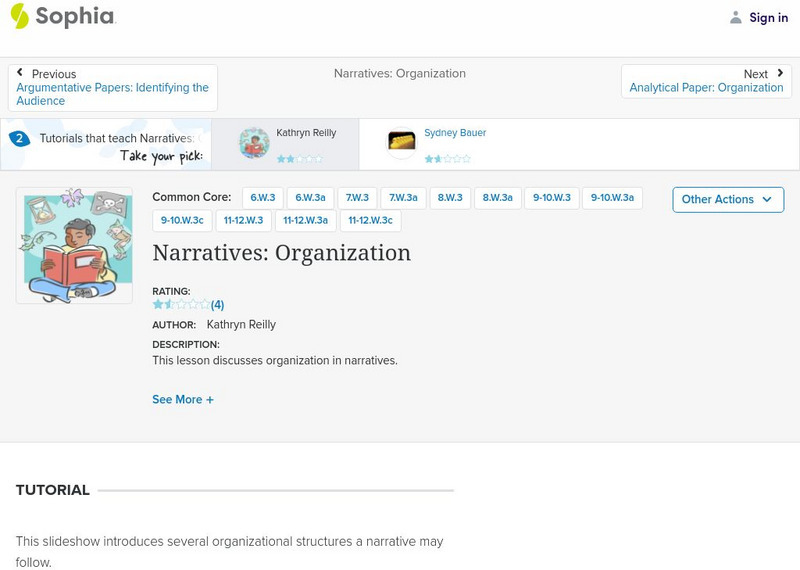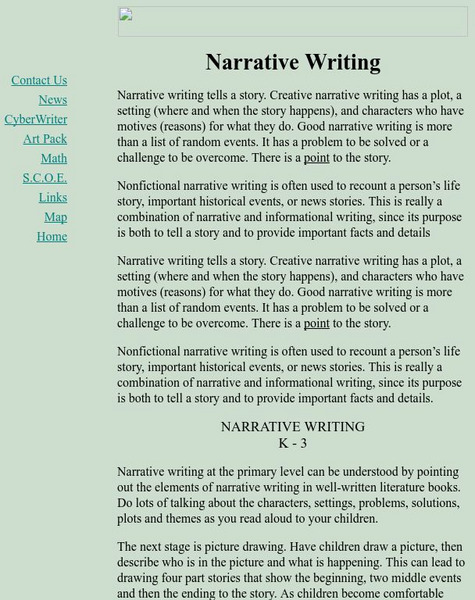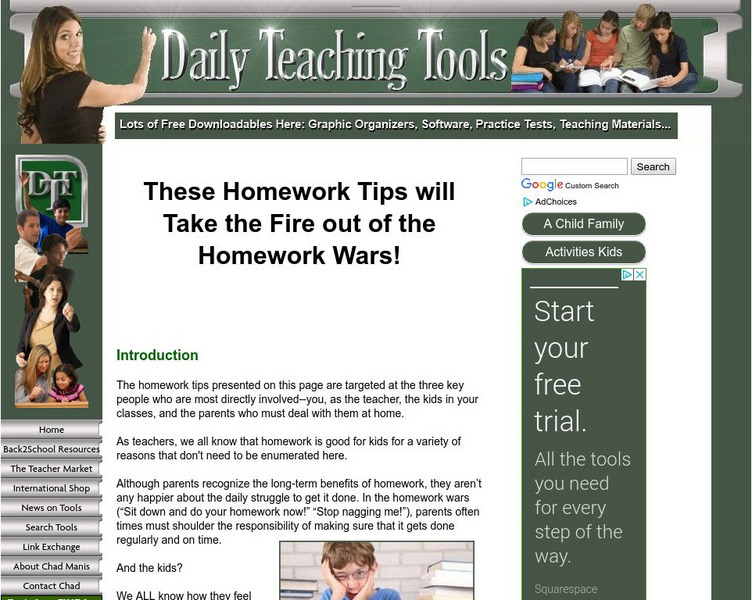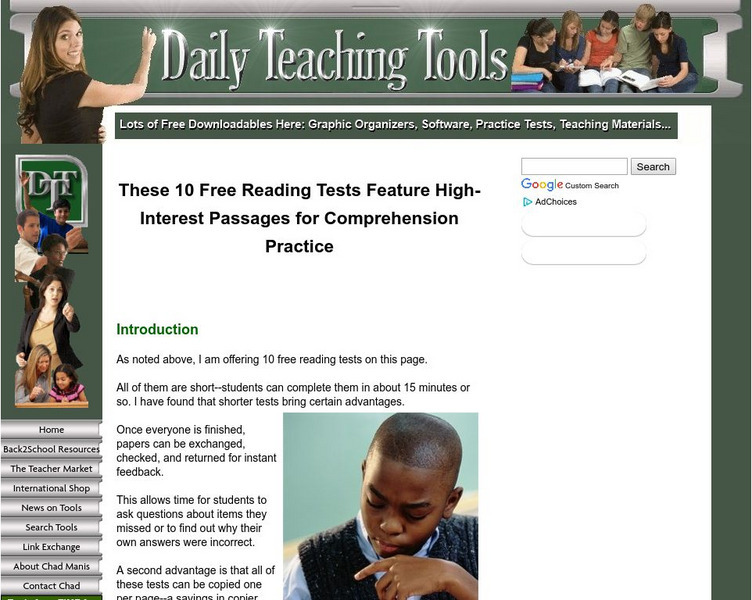Hi, what do you want to do?
Yale University
Yale University: Elements of the Short Story
This unit from the Yale University on elements of the short story is designed to develop student comprehension skills, particularly making inferences and generalizing. It also involves students in reading a number of short stories to...
Better Lesson
Better Lesson: W.4.4: Produce Clear Writing to Task, Purpose, Audience
Links to 89 lessons and activities that build student skills in standard W.4.4: Use a variety of transitional words and phrases to manage the sequence of events.
Writing Fix
Writing Fix:"oh, That's Good!" "No, That's Bad!"
How can something that is good, be bad and something that is bad, be good? Inspired by the pattern and concept in Margery Cuyler's picture book That's Good! That's Bad!, learners will brainstorm a sequence of related events as the story...
ReadWriteThink
Read Write Think: Integrating Language Arts: If You Give a Mouse a Cookie
This lesson integrates reading, writing, listening, and speaking to boost learners' comprehension skills. Students explore Laura Joffe Numeroff 's If You Give a Mouse a Cookie using a variety of techniques, beginning with a picture walk...
Education.com
Education.com: Draw the Story
[Free Registration/Login Required] Students will use their imagination to complete the story. How will it begin? How will it end? Great lesson for practicing sequencing.
Sophia Learning
Sophia: Prewriting
This tutorial focuses on prewriting using graphic organizers to fit the type of paper required. The video discusses the following graphic organizers: chain of events, cycle charts, looking at both sides of an issue, sequence ladder, Venn...
South Carolina Educational Television
Know It All: Sequencing Using Comics
Fifth graders will use comics in order to discover the importance of sequence while writing narratives.
Writing Fix
Writing Fix: Writing a Roundabout Story
In this lesson plan, If You Give a Mouse a Cookie, by Laura Numeroff, is used as a mentor text to highlight the trait of organization. The content focus of the lesson is to highlight that authors' story structures can be imitated. Story...
Florida Center for Reading Research
Florida Center for Reading Research: Narrative Text Structure: Sequence a Story [Pdf]
A lesson plan in which students read a narrative text and write the main events of the story on sentence strips. Materials are included.
Other
Thoughtful Learning: ccss.ela literacy.w.7.3.a
Pick and choose from these lessons and units that focus on narrative writing. Specifically, how to establish a context and point of view, introduce characters, and organize an event sequence.
Read Works
Read Works: Get Well Lance
[Free Registration/Login Required] This passage includes the story of a girl who is writing a get well note to a classmate. This passage is intended as a guided passage. It contains questions regarding explicit information and drawing...
Better Lesson
Better Lesson: W.3.3.b: Use Dialogue and Descriptions of Actions
Links to 2 lessons and activities that build student skills in standard W.3.3.b: Write Narratives to develop real or imagined experiences or events using effective technique, descriptive details, and clear event sequences.
Georgia Department of Education
Ga Virtual Learning:ninth Grade Lit and Comp: Introduction to Personal Narrative
This lesson is an introduction to a unit on personal narratives including the characteristics of a personal narrative: tells a story, events are in chronological order, and it has characters, setting, and plot. Click next at the bottom...
Education.com
Education.com: w.k.3 Worksheets
[Free Registration/Login Required] Choose from a variety of worksheets to reinforce the skill of writing to narrate a single event or several loosely linked events, tell about the events in the order in which they occurred, and provide a...
EL Education
El Education: If You Take a Dog to the Beach
Kindergarten students created this children's picture book. If You Take a Dog to the Beach was based on the commercial book series that includes If You Give a Moose a Muffin in which a sequence of events is kicked off by an initial...
Curated OER
Write Design: Graphic Organizers: Sequence
Lists and describes several types of graphic organizers which fall under the "sequence" mold, including a ranking table, continuum scale, cycle, bridging snapshots, series of events chain, and a problem/solution outline.
Sophia Learning
Sophia: Narratives: Organization
This slideshow lesson focuses on organizational structures for narratives including a review of narratives and a list of possible organizational structure types: chronological or sequential order, climactic order, in media, and...
Other
Cyberwriter: Narrative Writing
Cyberwriter gives narrative writing activities leveled for K-3rd grades and 4th-8th grades. A brief explanation about narrative writing is also on this page. CCSS.ELA-Literacy.CCRA.W.3
Daily Teaching Tools
Daily Teaching Tools: Introduction: Homework Tips
This Daily Teaching Tools resource provides a series of tips for homework completion. Students will be able to write a sequence of events more efficiently by using this tool.
Daily Teaching Tools
Daily Teaching Tools: 10 Free Reading Tests for Comprehension Practice
This Daily Teaching Tools resource provides ten short reading comprehension quizzes. Students will be able to write a sequence of events more efficiently by using this tool. All questions are skill-based and vary in levels of readability.
Curated OER
Write Design: Graphic Organizers: Sequence
Lists and describes several types of graphic organizers which fall under the "sequence" mold, including a ranking table, continuum scale, cycle, bridging snapshots, series of events chain, and a problem/solution outline.
Curated OER
Write Design: Graphic Organizers: Sequence
Lists and describes several types of graphic organizers which fall under the "sequence" mold, including a ranking table, continuum scale, cycle, bridging snapshots, series of events chain, and a problem/solution outline.
Curated OER
Write Design: Graphic Organizers: Sequence
Lists and describes several types of graphic organizers which fall under the "sequence" mold, including a ranking table, continuum scale, cycle, bridging snapshots, series of events chain, and a problem/solution outline.
Curated OER
Write Design: Graphic Organizers: Sequence
Lists and describes several types of graphic organizers which fall under the "sequence" mold, including a ranking table, continuum scale, cycle, bridging snapshots, series of events chain, and a problem/solution outline.





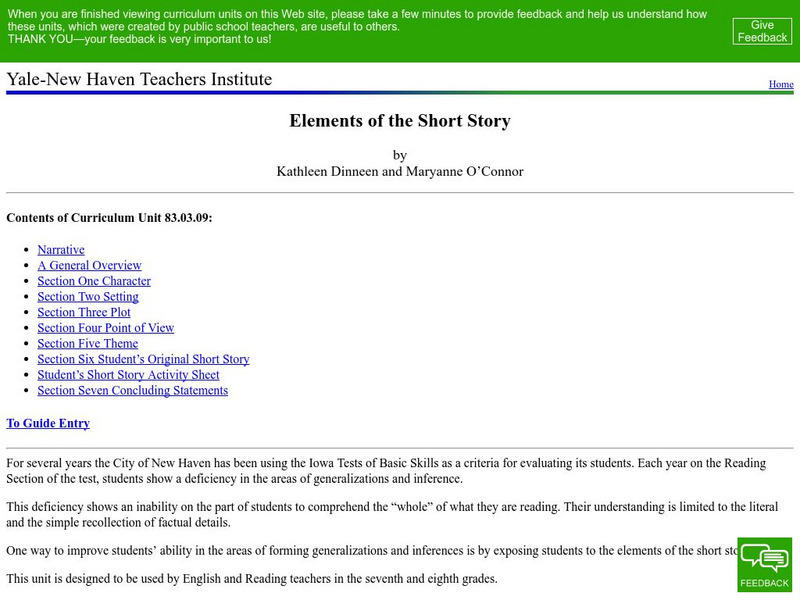

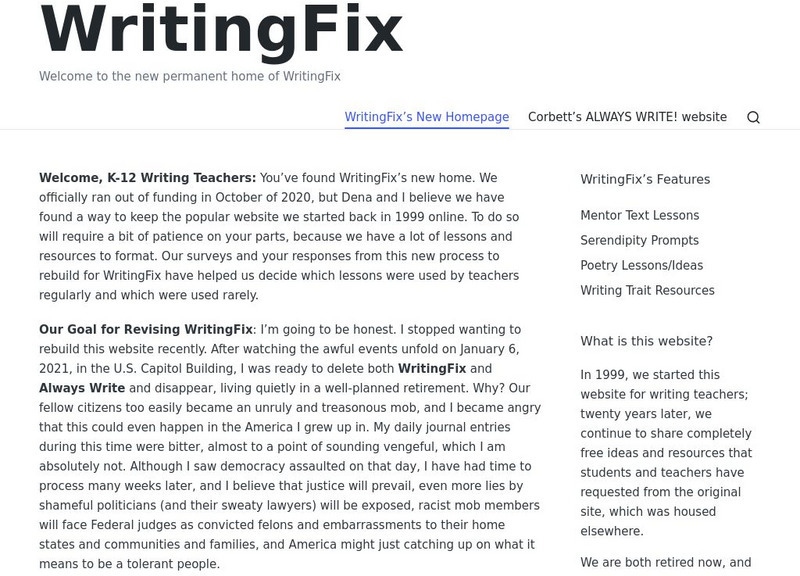
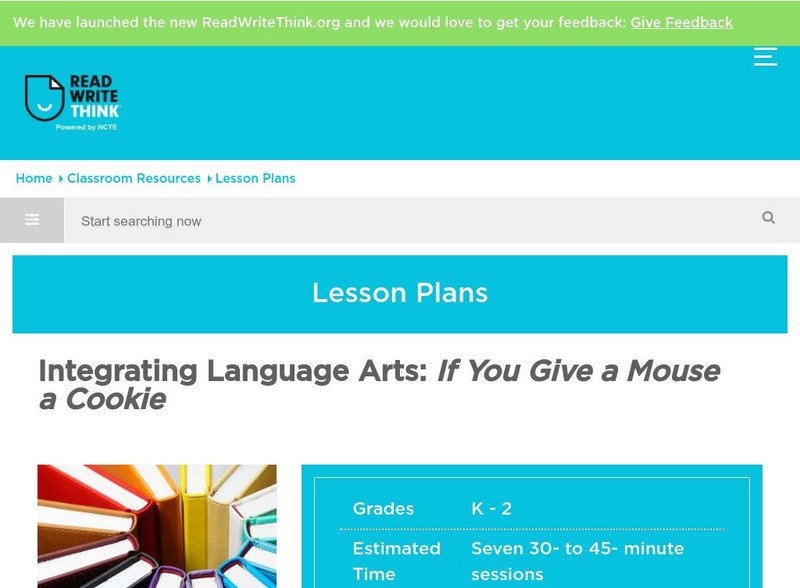

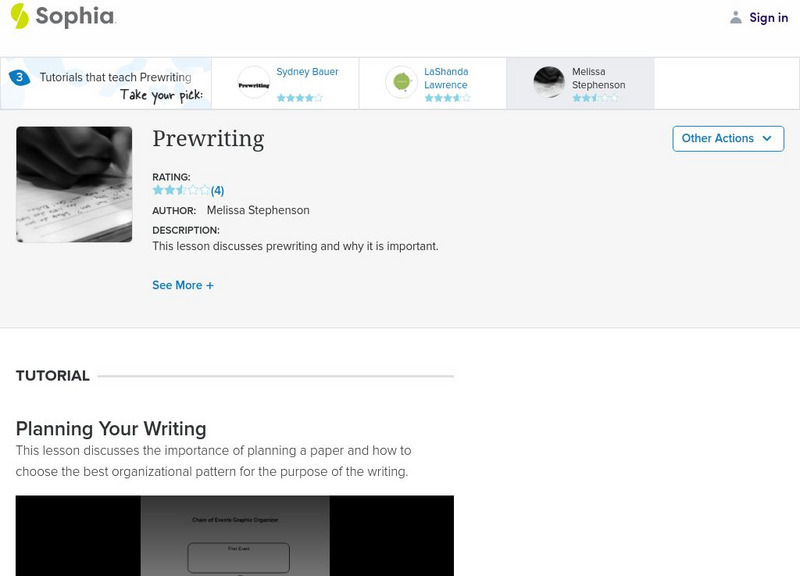

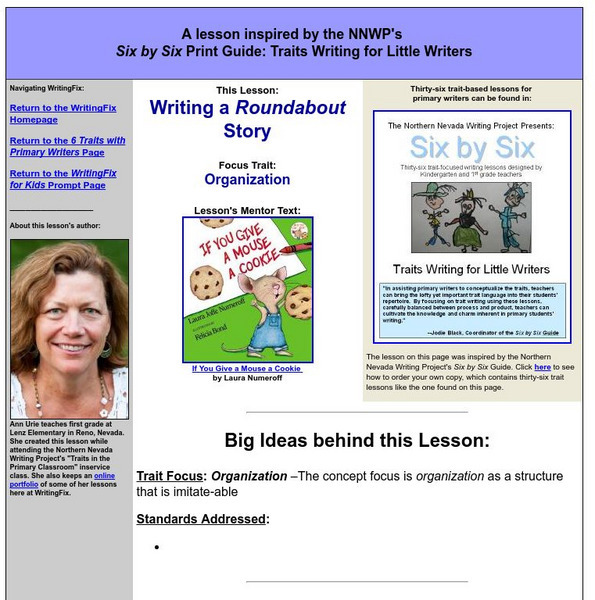
![Florida Center for Reading Research: Narrative Text Structure: Sequence a Story [Pdf] Lesson Plan Florida Center for Reading Research: Narrative Text Structure: Sequence a Story [Pdf] Lesson Plan](https://content.lessonplanet.com/knovation/original/509124-8f3f3c440d6b6d200b605de1c46e8d0a.jpg?1661786936)
